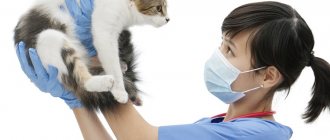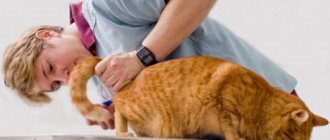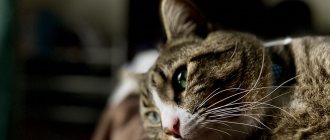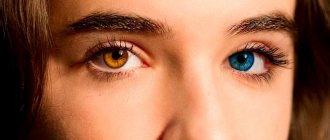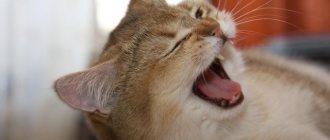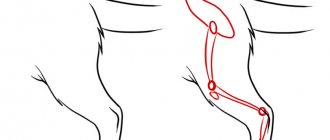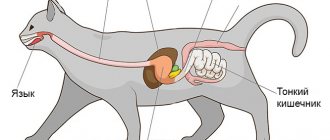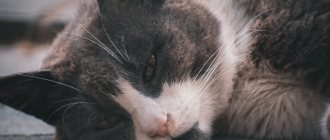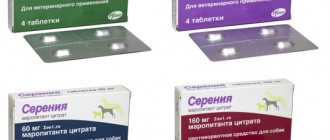The meaning of cat pupils
Over the years, the cat has evolved and adapted some of its natural habits, exemplified by its hunting preferences. Because of the dangers that lurked, the ancestors of today's cats were nocturnal animals that took advantage of the darkness of the night to feed themselves and, at the same time, protect themselves from potential predators. This is made possible by the anatomy of the eyes, which provides this animal with excellent night vision. To do this, the cat dilates the pupil as much as possible to facilitate the entry of the greatest amount of light. In addition, the eyes have a tissue called tapetum lucidum that, when combined, allows light to be absorbed and retained until it reaches the retina, resulting in much clearer vision at night.
During the day, the cat contracts the pupil and keeps it more or less closed depending on the amount of light there is. Thus we find the pupils of cats with three different shapes:
- Vertical pupil. It contracts to avoid excessive light penetration, as otherwise the animal would be completely blinded.
- Elliptical pupils. It is partially expanded.
- Round pupil. This occurs when a cat's pupil dilates fully, primarily in low-light spaces.
However, light is not the only reason that causes a cat to contract or dilate his pupils, as in many cases he does this as a reflex that shows his state of mind or health. Below we present these reasons.
Do cats have otherworldly vision?
Cat admirers often claim that their pets can see otherworldly phenomena that are inaccessible to our vision. This impression is due to some behavioral features of these animals. Sometimes they seem to be watching something invisible to us, and suddenly they jump up and rush, demolishing everything around. At the same time, the fur stands on end and the pupils dilate.
As zoologists say, this behavior is caused by a blurred picture that appears in the cat’s mind. Cats perceive everything that happens around them with their ears. Even a slight rustle in the absence of visual changes puts the animal in a state where it looks like a psychic communicating with spirits.
Cats see light waves that are inaccessible to our vision and hear ultrasound. Thanks to such abilities, these animals have greater ability to perceive the world.
Why does my cat have round pupils?
Having explained the function of the pupils in response to light, which is completely natural and typical for most animals, it is important to note that pupil dilation can also be due to other factors. So the answers to why your cat's pupils are dilated are numerous and may relate to situations or reactions to health problems. Focusing on these reasons associated with emotions and feelings, the cat’s round pupils express:
- Excitement: When an animal is very excited and nervous, such as during a play session, it is common to see round or elliptical pupils. However, excitement does not always occur due to positive stimuli, as it can also occur due to stress or anxiety.
- Satisfaction: In situations that create happiness, the cat will also dilate its pupils as a reflex. An example would be when we fill a food bowl.
- Fear: The cat has dilated pupils and eyes wide open. This is a clear sign of fear, which can be caused by change, loud noise, situation, etc.
- Aggression: Cats dilate their pupils when they look at their prey and prepare to attack, so if you look at yours in this way, you will feel threatened and consider defending yourself.
While some reasons for why a cat has round pupils are positive, it is important to note that this is not the usual way. In any case, dilatation indicates that the animal is not relaxed, and if it is due to him playing, we should not worry. But if we see dilated pupils most of the day, we should start to think that our cat is not healthy. It is possible that the animal is stressed by something and does not feel comfortable or safe, and it is our duty to find the reason that prevents it from restoring emotional stability.
On the other hand, it is important to emphasize that every cat is a world and can develop its own forms of communication, so dilated pupils are not always a reason for warning. By this we do not mean that we should not attach due importance to this, but it is important to know our cat, his character, behavior and reactions in order to learn how to identify the warning signal. Likewise, there are cat breeds with a predisposition to display elliptical or dilated pupils without causing an underlying problem, such as the British Shorthair.
Cat vision
We have studied a lot of available materials and collected only objective and indisputable facts that will allow us to better understand cats, and, if desired, to feel the world through the prism of their perception. This article is about cat vision. For humans, vision is perhaps the most basic sense. How are things going with cats?
Of course, vision is also very important for cats; it allows them to perceive the outside world, gives them an idea of the surrounding objects, their size, shape, and movement. However, unlike you and me, cats have significantly developed senses that help them navigate in space. They have whiskers (vibrissae), the most important organ of touch, which makes it possible to navigate at close range. And over long distances they are helped by their sense of smell, which is developed in them, although somewhat less well developed than in dogs, but much better than in humans. For example, to find water, a person must see it, but a cat can find it by smell.
When vision deteriorates, the cat compensates for this so successfully with other senses that owners may not immediately pay attention to it and will notice it only when the problem has become serious. That is why it is important for us to understand the visual characteristics of cats, to know the symptoms of disorders of this function and, of course, recommendations for eye care.
SIGNS OF BLINDNESS IN CATS
- The cat refuses to jump or does it awkwardly.
- The cat stumbles upon objects that are in a new place for it.
- The cat looks past you.
- The cat's pupils are statically dilated.
If your cat has lost her sight, remember that she should not be allowed out of the house, and it is not advisable to rearrange the furniture, as well as food and water bowls.
When a cat knows where something is, it can navigate perfectly even blindly, using its other senses. Cats' vision is in many ways similar to human vision, but there are a number of differences. Let's look at the main characteristics of cats' vision.
Cats have 3D vision
Cats' eyes are located close to each other and directed forward. The sectors that the cat perceives with its right and left eyes overlap, which allows it to see the same object with both eyes at the same time. Thanks to this, cats are able to determine the shape, size of an object and the distance to it. The angle of binocular vision in cats is 140 degrees.
A cat also has a fairly large viewing angle - 200 degrees (for humans - 180 degrees). 3D vision helps a cat accurately assess the location of an object, which is especially important when hunting. But the rodents that cats hunt have eyes on both sides of their heads, and they see two separate pictures.
Cats see better in the horizontal plane
Preparing to jump, the cat shakes its head up and down in order to, by changing the angle of view, determine the distance to the object as accurately as possible. It has been proven that a cat reacts more actively to the movement of objects in the horizontal plane than to vertical movement, because mice move precisely in the horizontal plane. Cat owners should take this into account when inviting their cat to play.
Cats have trouble seeing up close
Cats cannot clearly focus their gaze on nearby objects. The minimum distance at which a cat can see well is about 50 cm. If you put an object directly under the cat’s nose, then she will explore it by touching it with her whiskers (vibrissae), and not with the help of her eyesight. That is why owners, when playing with a cat, need to keep the toy at a sufficient distance.
Cats see the world primarily in shades of gray
A cat's eyes are designed in the same way as a person's. Light passes through the cornea, the anterior chamber of the eye, the pupil, the lens, the vitreous body and hits the retina (the inner light-sensitive membrane).
Photoreceptors (special nerve cells) on the retina of a cat's eye convert the light falling on them into nerve signals, which are then transmitted to the brain.
Photoreceptors vary in shape and are divided into two types: rods and cones.
The rods contain only one type of pigment; they provide twilight, colorless vision.
Cones contain two types of pigment, and they form the basis of cats' two-tone daytime color vision. (In humans, there are three types of pigment in cones, and therefore three-color vision).
In a cat, like a twilight animal, rods predominate on the retina of the eye, and only in the central part are cones concentrated; This is the area of acute vision. The ratio of rods to cones in cats is 25:1, and in humans it is 4:1.
A cat can distinguish shades of color much worse than a human. They see clearly only in the blue and green-yellow parts of the spectrum. But at the same time, cats are able to distinguish a large number of shades of gray. This feature of vision can be explained by the color of the main victims of cats - mice, the color of which varies from light gray to brownish-gray. Therefore, when buying a bright toy, you are doing it for yourself, and not for the cat. Opt for gray tones.
Cats prefer twilight
The statement that a cat sees perfectly in the dark is not entirely true. In absolute darkness, a cat cannot see. But in order to see well, a very small amount of light is enough for her - ten times less than for a person.
Cats' vision is tuned to perceive dimly lit spaces, which is especially important for hunting, since small rodents lead a twilight and nocturnal lifestyle. And in good lighting, a cat distinguishes details worse than a human, preferring darkened rooms.
Excellent vision in the twilight of cats is provided by a special formation - tapetum, which humans do not have. Light, passing through the rods and cones, is reflected from the tapetum, returns and again irritates the nerve endings. Thus, the rods and cones in the cat’s eye are irritated twice, which helps improve visibility at dusk and explains the cats’ dislike of bright light. It's also interesting that the tapetum causes a cat's eyes to glow in the dark as light reflects off its greenish-yellow surface.
A cat's pupil may narrow to a narrow slit.
In bright light, cats' pupils constrict to a narrow vertical slit—a very effective way to reduce light output.
Cats watch every move
Cats recognize a moving object better than a stationary one. They can see a moving object at a distance of 800-900 m. On the retina, a moving object sequentially activates groups of photoreceptors, then the information goes to the brain, where specific cells (moving edge detectors) make cats react to the presence of prey or an enemy.
That is why, during a hunt, a cat can simultaneously guard several mouse holes, instantly reacting to the subtle movement of rodents.
Cats have a third eyelid
The third eyelid can be seen in the inner corner of the eye. It can be light pink or pigmented. The third eyelid helps tear fluid move through the eye and further protects the eye.
EYE DISEASES
Healthy cat eyes are clean, wide open and do not require special care - you just need to examine them periodically and wipe them with a damp cloth as necessary. Also, your cat’s eyes need to be washed if you notice slight red-brown crusts in the inner corner of the eye or slight tear stains. However, since eye diseases are, alas, not uncommon for cats, if suspicious changes appear in the eye area, it should be shown to a veterinarian.
It is important to note that diseases that affect the eyes of cats can be not only ocular, but also systemic. A number of infectious diseases occur with purulent discharge from the eyes, for example, feline herpesvirus type 1 (infectious rhinotracheitis) and chlamydia.
Therefore, it is so important to start treatment on time. This will save your pet not only his eyes, but also his life.
BE ALERT IF ANY DEVIATIONS APPEAR:
| in cat behavior: | in eye condition: |
|
|
Since the number of diseases is very large, of course, there is no universal cure. You should not hope that the disease will go away on its own. You can't spread the disease!
You cannot self-medicate! Be sure to show your cat to a veterinarian!
The only thing you can do yourself before visiting a specialist is to wash your cat’s eyes with water or any eye wash solution, for example, furacillin solution or chamomile decoction. You can also apply 1% tetracycline eye ointment to the lower eyelid. Throughout the course of the disease, the cat needs special daily care - it is necessary to clean and rinse its eyes before using medications.
When the doctor makes a diagnosis and prescribes treatment, the cat owner should follow simple rules to achieve optimal results and a speedy recovery for the pet.
- First, strictly follow all doctor’s instructions,
- secondly, observe the cat, carefully monitor changes in its condition and in case of any deviations, be sure to consult a doctor.
- Third, use an Elizabethan collar to prevent the cat from rubbing its already sore eyes. Only remove it when your cat is feeding.
THE MOST COMMON EYE DISEASES IN CATS
Conjunctivitis is an inflammation of the mucous membrane of the eyes. Keratitis is inflammation of the cornea. Entropion of the eyelids (more common in Persian, British, Scottish cats, Maine Coons). Sequestration (necrosis) of the cornea. Epiphora - profuse lacrimation. Retinal detachment (usually associated with hypertension)
HOW TO WASH A CAT'S EYES?
- It is necessary to prepare an eye wash solution, sterile gauze pads or clean cotton pads in advance. Remember that the solution must be at room temperature. Do not use the solution straight from the refrigerator!
- Remember to wash your hands thoroughly.
- It is very important to securely restrain the cat so that it does not injure you or itself. It is advisable not to carry out the procedure alone; use the help of other family members.
- If crusts have formed around the eyes, generously moisten a napkin with the solution and soak the crusts for 1-2 minutes. Then carefully remove the soaked formations from the wool.
- You can wash your eyes with a cloth soaked in the solution, using a syringe with the needle removed, or a syringe. Gently part your eyelids and apply the solution to the upper outer corner of your eye.
- Wipe the eye area, eyelids and fur with a dry cloth from the outer to the inner corner of the eye.
Source: My friend the cat 2012-09
Cat with pupils dilated due to health problems
The most common conditions and diseases that indicate pupil dilation as a symptom are:
- glaucoma
- uveitis
- renal failure
- hypoglycemia
- Leukemia pertussis virus (FelV)
- Some types of cancer
- poisoning
- Head injury
- Feeling discomfort or injury to the eyes
- anisocoria
In the following sections, we will look at some of these problems, which will also help us understand why a cat's pupils are dilated and not moving.
Anisocoria in cats - one pupil is larger than the other
Anisocoria in cats is a condition in which the animal presents unequal pupils such that one is more or less dilated than the other. This problem does not only affect cats, as it can also occur in other animals, including humans. In certain situations, this difference can be habitual, however, when it becomes constant, it is not normal and we must act.
To find out if your cat is suffering from this problem, we'll look at the most common signs. In addition to the obvious asymmetry of the pupils, another symptom of anisocoria in cats is associated with obvious discomfort in the eyes, so it is common to see the affected animal scratching its eyes frequently. Likewise, in most cases, another sign present in anisocoria is a bluish discoloration of the eyes, indicating opacity and/or redness. You can also observe the presence of copious discharge that does not allow you to open your eyes normally. All of these symptoms can harm the animal's vision, so it is likely that he will collide with objects or furniture and become strange or disoriented. Apathy and decay usually appear as a result of general malaise.
Anisocoria is a symptom that can develop as a result of other diseases or eye problems, such as feline leukemia, corneal ulcers and uveitis. Therefore, if your cat has asymmetrically dilated pupils, you should contact your veterinarian to find the underlying cause, as treatment will depend on this.
Dilated pupils in cats due to glaucoma and other eye pathologies
Glaucoma in cats is a disease involving increased fluid pressure inside the eye. In cats' eyes and in ours, there are drainage channels that, if blocked, cause water to accumulate and therefore increase intraocular pressure, causing glaucoma and other problems that arise from it, such as blindness.
However, glaucoma is not an ocular condition that can cause dilated pupils in cats. Likewise, this pathology can also appear as a consequence of another, so it is important to analyze all eye problems that may have round pupils as a symptom:
- Retinal disinsertion
- Uveitis
- Progressive retinal atrophy
- Optic nerve disorders
- Corneal damage
- Ocular tumor
- Cataract
Dilated pupils in a cat due to kidney failure
As with glaucoma or anisocoria, kidney failure is more common in older cats. However, it is also possible to observe this pathology in young cats, so we should not rule out if the symptoms overlap. While it may be strange to refer to kidney failure with dilated pupils, the truth is that there is a good excuse for it. When a cat suffers from kidney failure, it also suffers from hypertension, which in turn causes several eye problems such as hemorrhage, retinal detachment, blindness, etc. For this reason, the cat may dilate its pupils and turn this sign into another symptom of the disease.
In addition to eye problems and dilated pupils, symptoms of kidney failure in cats that may alert them to its presence include:
- Apathy
- Loss of appetite
- Weight loss
- Polydipsia and polyuria (drinking and urinating a lot)
- Vomit
- Diarrhea
- Excessive hair loss
- Dehydration
- Pale mucous membrane
If your cat has dilated pupils and doesn't move much, this could be the reason. Kidney failure should be treated immediately as it is a serious condition that can lead to the death of the animal. Consult your veterinarian for more information, especially if your cat is older than 7-8 years and has one or more of these symptoms.
Possible causes of constricted pupils in a cat
Quite often, the pupils of cats become very narrow even in moderate lighting or in twilight. According to veterinarians, this can be caused by:
- painful sensations;
- estrus period (read more about the cat’s first estrus);
- a sharp release of adrenaline into the blood (possible during stressful situations, moving, visiting a veterinary clinic, hunting, and even during active, outdoor games);
- anger, aggression, desire for revenge.
In most cases, excessive constriction of the pupil in a cat is not a cause for concern, as it is explained by natural processes occurring in the animal’s body.
Tips for cleaning your cat's eyes
Although we have seen that the reasons why a cat has dilated pupils a lot and does not necessarily mean a lack of cleanliness, it is always advisable to maintain good hygiene in this part of the body to avoid irritation or problems caused by dirt. Here are some tips:
If the cat produces many legions, they should be removed every morning with sterile gauze and physiological serum or chamomile in its absence. It is good to fix the cleaning routine of the most delicate areas such as the eyes and ears. For adopted cats this is also important, always little by little and through positive reinforcement. If the hair around the eyes is too long, it needs to be trimmed to prevent it from getting into the eyes and causing damage. If your cat develops ocular discharge, inflammation, redness, or excessive itching, it should be taken to a veterinarian as soon as possible.
This article is for informational purposes only, we are not in a position to prescribe veterinary procedures or make any diagnoses. We invite you to take your pet to the veterinarian in case of any conditions or discomfort.
